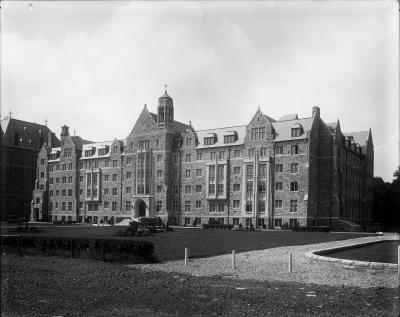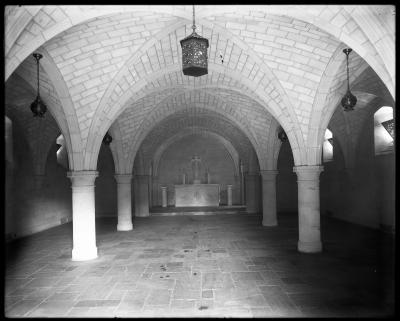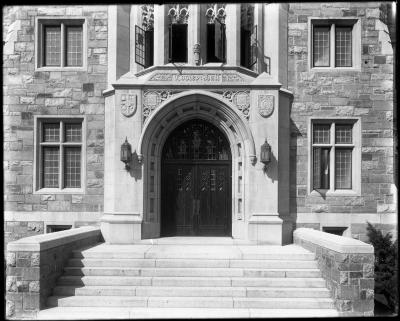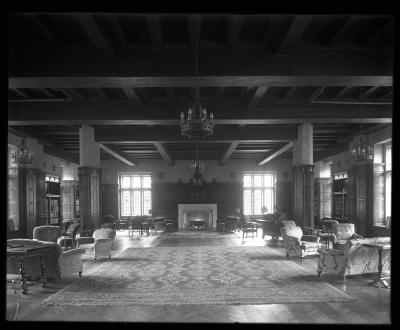Copley Hall is a residence hall on the western side of the quadrangle at Georgetown University. Designed by Emile G. Perrot, it was built between 1930 and 1932 at a cost of $744,000. It comprises 99,286 square feet. It is named for Father Thomas Copley, S.J. (1596 - 1652), an early Jesuit missionary in Maryland.
Design
Copley Hall's architecture has several notable design elements related to Georgetown and United States history. The main gable bears an inscription in Latin, the translation of which is: "Loyola's fortune still may hope to thrive/If men and mould like those of old survive." Above this is the seal of Georgetown. Above the entrance is a three-story bay window with four major seals: (1) Sodality, (2) Athletics for physical education (including emblems for baseball, football, track, tennis, golf, and basketball), (3) the Philodemic for the Debating Society, and (4) the Journal for Writers. The northern tower bears the Cross and the Seal of the United States.1
The south gable has three historic emblems: (1) St. Ignatius's family crest, "Onaz y Loyola" the founder of the Jesuits, (2) the Lily of the seal of the University of Paris (where St. Ignatius was educated and founded the Jesuits), and (3) the seal of the Society of Jesus surrounded by a crown of thorns.
The northernmost bay window depicts twelve famous Georgetown alumni, including Edward Douglass White, William Gaston, James Ryder Randall, and William W. Corcoran
Interior Features
Copley Hall was initially designed with four floors, with suites of two and four, accommodating around 180 students in total.2 The original design also included a bowling alley and recreation room in the basement.
Inside, Copley Hall houses the Reading Lounge for the Senior Class on the first floor of the north wing. At the west end of this room is a fireplace above which once hung a buffalo head shot by Colonel William Cody (Buffalo Bill) in 1872 and given to General Philip Henry Sheridan. It was eventually acquired by a Georgetown alumnus who donated it to the University.2 Copley Hall also houses Copley Formal Lounge, which has been the site of dinners, celebrations, and speaker events.
Since Copley Hall was originally designed as an upperclassmen dorm, the dormitory was designed to include religious spaces to help seniors connect with their faith in their last year at Georgetown. Copley Hall is home to both St. William and Copley Crypt Chapel. St. William Chapel was renamed the Servant of God Sr. Thea Bowman Chapel of St. William and is currently the location of weekly Protestant service. Copley Crypt Chapel hosts Roman Catholic and Eastern Orthodox services, especially wakes for Jesuits before their burial in the Jesuit Cemetery below the Chapel.4
Notable Events
On September 4, 1939, the building's central tower was struck by lightning, dislodging several of the limestone bricks. It was repaired in October of that year at a cost of about $800.3
On January 23, 1946, Navy Chaplain Father Joseph Timothy O'Callahan, S.J. was honored at a reception in Copley Hall after receiving the Congressional Medal of Honor from President Truman earlier that day.4
When Georgetown became fully coeducational in 1969, Copley was the first dorm to house both men and women.5 Kober-Cogan, on the medical campus, had become coed in 1961 to accommodate the growing number of female students in the School of Nursing, the School of Foreign Service, the Business School, and the Institute of Languages and Linguistics.6
In 1979 Copley's resident director, Rev. Robert Hummel, actively supported the creation of Georgetown's first gay student group.7
Renovation
Copley Hall received a renovation costing $12.5 million in 1994-1995, at which time it contained 324 dorm beds. Its most famous resident is President Bill Clinton (SFS 1968), who lived in room 410 during the 1966-1967 school year.8
Both Copley Crypt and St. William chapels also undertook renovations in 2018 and 2020, including added iconography and stained glass, mobility ramps, and external work.9
- 1Francis X. Ballman, "Copley Hall," Building Outlines Campus Buildings, 1789 – 1995, Father Lawrence Hurley Memorial Edition, Francis X. Ballmann and the Division of Facilities, 1995, p. 9.
- 2"Work to Start on Senior Dormitory." The Hoya, Vol. XI No.13, Jan 15, 1930.
- 2Francis X. Ballman, "Copley Hall," Building Outlines Campus Buildings, 1789 – 1995, Father Lawrence Hurley Memorial Edition, Francis X. Ballmann and the Division of Facilities, 1995, p. 10.
- 4"Copley Crypt Chapel." Georgetown Campus Ministry. https://campusministry.georgetown.edu/copley_crypt/
- 4Francis X. Ballman, "Copley Hall," Building Outlines Campus Buildings, 1789 – 1995, Father Lawrence Hurley Memorial Edition, Francis X. Ballmann and the Division of Facilities, 1995, pp. 10 - 11.
- 3"Start Reconstruction on Weakened Tower," The Hoya, October 25, 1939, Vol. XXI No. 4, p. 1. http://hdl.handle.net/10822/1047668
- 5"Girls in Copley Seen to be Necessary Evil," The Hoya, March 13, 1969, Vol. LII No. 18, p. 8. http://hdl.handle.net/10822/555315
- 6"Kober-Cogan to House Co-eds Next Semester," The Hoya, March 16, 1961, Vol. XLII No. 19, p. 1. http://hdl.handle.net/10822/555128
- 7Greg Kitsock, "Hummel Discharged by Virginia Diocese," The Hoya, March 9, 1979, p. 3. http://hdl.handle.net/10822/555055
- 8Francis X. Ballman, "Copley Hall," Building Outlines Campus Buildings, 1789 – 1995, Father Lawrence Hurley Memorial Edition, Francis X. Ballmann and the Division of Facilities, 1995, p. 12.
- 9Martin, Olivia. "Copley Crypt Opens after Year-Long Renovation." The Georgetown Voice, Nov 24, 2019. https://georgetownvoice.com/2019/11/24/copley-crypt-opens-after-year-long-renovation/.





